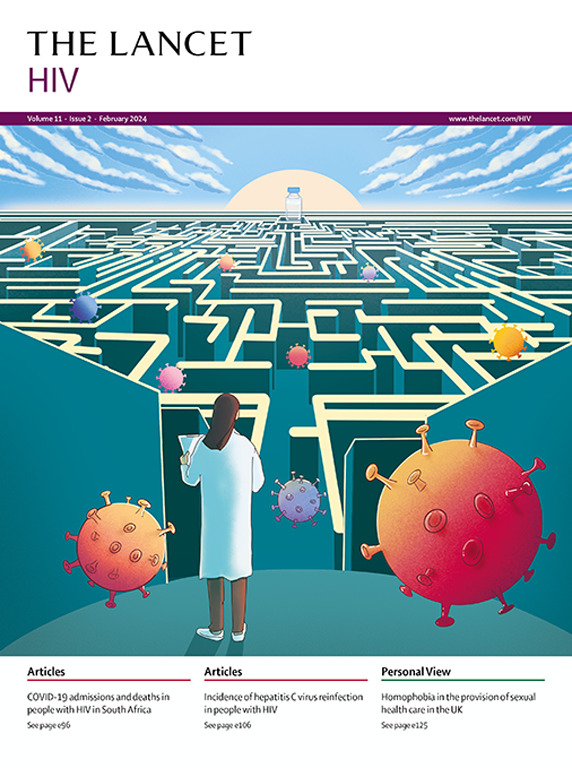建立长效注射卡波特韦和利匹韦林治疗的病毒学失败和停药的共同定义(CONSENSUS-LAI研究):一项国际调查和德尔菲过程。
IF 13
1区 医学
Q1 IMMUNOLOGY
引用次数: 0
摘要
背景长效注射卡波特韦和利匹韦林抗逆转录病毒治疗的病毒学失败和停药的定义在临床实践和观察性研究中是不一致的,这使得研究结果的解释和实施变得复杂。CONSENSUS-LAI研究旨在建立病毒学失败和停止治疗的一致定义,以增强证据可转移性并支持最佳临床结果。方法本研究分为两个阶段。第一阶段是在2024年4月25日至7月1日期间进行的一项国际在线调查,探讨病毒学和治疗中断的现有定义。符合条件的参与者是从事传染病或性健康服务的保健专业人员,他们在过去6个月内至少为10名艾滋病毒感染者提供过护理,在临床试验或临床实践中开过卡波特韦和利匹韦林处方,并且能够给予知情同意。参与者是通过社交媒体和医学专家协会的邮件列表招募的。第二阶段是德尔菲过程,在该过程中,选出一个专家小组,以确保来自世卫组织所有六个区域的代表,以9分的李克特量表对第一阶段的主要定义进行评分。提出的定义根据四个效度标准进行评分:清晰度,专家设置的可用性,临床目的的适当性,以及相关人群的适用性。多次提出修订建议,直至达成协商一致意见。共识被预先定义为至少75%的专家同意或强烈同意(得分7-9)与有效性标准。来自28个国家的386名LAI卡波特韦韦和利匹韦林处方者完成了调查,揭示了15种LAI卡波特韦韦和利匹韦林病毒学失败的定义和9种停止治疗的定义。52名专家参与了德尔菲过程。经过两轮对所有有效性标准的讨论,双方就两种定义达成了共识。对于病毒学失败,一致的定义如下:(a)病毒载量200拷贝/ mL或更多,两次间隔2-4周,或(b)单个病毒载量超过1000拷贝/ mL,和/或(c)在及时注射和事先抑制低于200拷贝/ mL的情况下出现耐药性,或(d)持续治疗无法将病毒载量抑制至低于200拷贝/ mL。对于停药的共识定义如下:未连续两次注射卡波特韦和利匹韦林且在此期间未服用口服桥接的LAI患者,无论停药原因为何。共识定义为调整实践和评估患者结果提供了基础。需要进一步验证病毒学失败的病毒载量阈值和最佳病毒载量重测窗口。FUNDINGViiV医疗保健。本文章由计算机程序翻译,如有差异,请以英文原文为准。
Establishing shared definitions of virological failure and discontinuation for long-acting injectable cabotegravir and rilpivirine therapy (the CONSENSUS-LAI Study): an international survey and Delphi process.
BACKGROUND
Definitions of virological failure and treatment discontinuation for long-acting injectable (LAI) cabotegravir and rilpivirine antiretroviral therapy are inconsistent in clinical practice and observational studies, which complicates interpretation and implementation of findings. The CONSENSUS-LAI study aimed to establish consistent definitions of virological failure and treatment discontinuation to enhance evidence transferability and support optimal clinical outcomes.
METHODS
The study had two phases. Phase 1 was an international online survey exploring existing definitions of virological and treatment discontinuation, conducted between April 25 and July 1, 2024. Eligible participants were health-care professionals working in infectious disease or sexual health services who had provided care to at least ten people living with HIV in the past 6 months, had prescribed LAI cabotegravir and rilpivirine in clinical trials or clinical practice, and were able to give informed consent. Participants were recruited via social media and mailing lists of medical specialist societies. Phase 2 was a Delphi process, in which a panel of experts, selected to ensure representation from all six WHO regions, scored leading definitions from phase 1 on a 9-point Likert scale. The proposed definitions were scored according to four validity criteria: clarity, usability in the expert's setting, appropriateness across clinical purposes, and applicability across relevant population groups. Revisions were suggested in iterative rounds until consensus was reached. Consensus was predefined as at least 75% of experts agreeing or strongly agreeing (scores 7-9) with the validity criteria.
FINDINGS
386 LAI cabotegravir and rilpivirine prescribers across 28 countries completed the survey, revealing 15 definitions for virological failure on LAI cabotegravir and rilpivirine and nine for treatment discontinuation. 52 experts participated in the Delphi process. Consensus agreement on both definitions was reached after two rounds for all validity criteria. For virological failure, the consensus definition was as follows: (a) viral load 200 copies or more per mL or more on two occasions 2-4 weeks apart, or (b) a single viral load of more than 1000 copies per mL, and/or (c) emergent resistance, in the context of timely injections and prior suppression of less than 200 copies per mL, OR (d) unable to suppress viral load to less than 200 copies per mL on continuous therapy. For treatment discontinuation the consensus definition was as follows: people on LAI cabotegravir and rilpivirine who have missed two consecutive injections and have not taken oral bridging in the interim, irrespective of reason for discontinuation.
INTERPRETATION
The consensus definitions provide a foundation for aligning practice and evaluating patient outcomes. Further validation of the viral load threshold for virological failure and the optimal viral load retesting window is required.
FUNDING
ViiV Healthcare.
求助全文
通过发布文献求助,成功后即可免费获取论文全文。
去求助
来源期刊

Lancet Hiv
IMMUNOLOGYINFECTIOUS DISEASES&-INFECTIOUS DISEASES
CiteScore
19.90
自引率
4.30%
发文量
368
期刊介绍:
The Lancet HIV is an internationally trusted source of clinical, public health, and global health knowledge with an Impact Factor of 16.1. It is dedicated to publishing original research, evidence-based reviews, and insightful features that advocate for change in or illuminates HIV clinical practice. The journal aims to provide a holistic view of the pandemic, covering clinical, epidemiological, and operational disciplines. It publishes content on innovative treatments and the biological research behind them, novel methods of service delivery, and new approaches to confronting HIV/AIDS worldwide. The Lancet HIV publishes various types of content including articles, reviews, comments, correspondences, and viewpoints. It also publishes series that aim to shape and drive positive change in clinical practice and health policy in areas of need in HIV. The journal is indexed by several abstracting and indexing services, including Crossref, Embase, Essential Science Indicators, MEDLINE, PubMed, SCIE and Scopus.
 求助内容:
求助内容: 应助结果提醒方式:
应助结果提醒方式:


